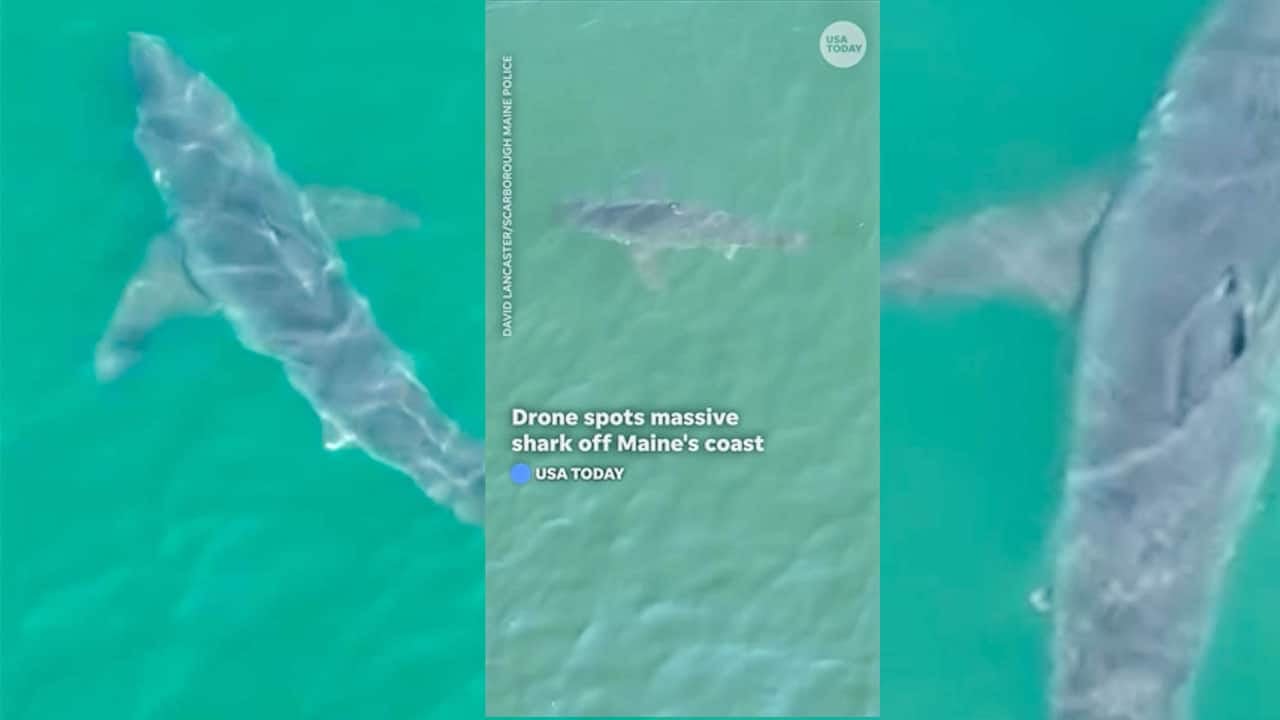Drone Captures Amazing Great White Shark Sighting in Maine
A breathtaking scene was unveiled off the coast of Maine, reminiscent of a nature documentary, when a drone captured stunning footage of a massive great white shark swimming near some of New England’s favorite vacation beaches. This guide explores why this sighting is so remarkable, its implications for beachgoers and surfers, the revolutionary role of drones in wildlife observation, and safety tips for the Atlantic coast. Additionally, we bring insights from Maine locals and experts, combining facts with a maritime charm.
Eye in the Sky: The Drone That Spotted a Legend
Imagine being a fisherman ending a warm August day at Scarborough, Maine. Between Pine Point Beach and Crescent Beach State Park, a shadow moves beneath the waves. Suddenly, a distinct grey fin slices through the water. This time, it’s not beachgoers staring in awe from the sand—it’s a drone, expertly navigated by clam fisherman David Lancaster, capturing footage that quickly spread through local news and communities.
David shared, “It was pretty crazy to see in the local waters. There are some really amazing creatures in the sea. It’s in the back of your head, but you have to accept it.” The drone’s high-resolution footage not only spotted the 10-to-12-foot shark but offered a unique birds-eye perspective of an apex predator in its element.
Why This Sighting Matters
Great white sharks have long been part of legend, perhaps most famously depicted (and slightly vilified) in the 1975 film “Jaws.” Historically rare along Maine’s rocky coast, their presence is now becoming more noticeable.
- Geography: Unlike usual visitors like striper fish, seals, and porpoises, great whites seldom share Maine’s waters. The region’s first and only deadly shark attack occurred in July 2020 near Harpswell.
- Size and Species: Estimated to be up to 12 feet long, this shark is larger than most SUVs and represents a charismatic marine megafauna commonly found in North America.
Factors Attracting Sharks to Maine: Science and Speculation
When considering global warming and shifting marine populations, you’re on the right track.
- Climate Change: Warmer ocean waters are pushing marine life north, including shark prey like seals. “As climate change progresses and warm waters move northward, sharks might linger longer into winter or fall,” notes Matt Davis, a marine expert with the Maine Department of Marine Resources.
- Seal Boom: Maine’s coastlines are increasingly populated with seals, a favorite meal for white sharks. Unlike Cape Cod’s concentrated shark activity due to large seal populations, Maine’s rugged coast disperses these animals, leading to occasional sightings along its lengthy shores.
- Conservation Success: Due to stricter regulations since the 1990s and efforts by organizations like Ocearch to track and protect sharks, great white populations are on a slow rebound, making occurrences slightly more frequent yet still exceptional.
Drones: The Modern Ocean Guardians
Drones have become essential in marine research, beach safety, and creating captivating aerial images.
- Wildlife Tracking: Drones can observe and track animals across large areas, alerting researchers, lifeguards, and the public about large predators in the vicinity.
- Public Safety: As seen in Scarborough, drone footage is pivotal for authorities to issue timely alerts, enhancing “situational awareness” for communities.
- Citizen Scientists: Local fishermen and boaters, like David Lancaster, provide “eyes in the sky,” contributing to safety and science with each drone flight.
Staying Safe (and Sane) on Maine’s Beaches
The presence of large fins raises significant safety questions. Here’s practical advice from the Maine Department of Marine Resources:
- Swim or surf close to shore—sharks generally avoid shallow, crowded waters.
- Avoid areas with seals, schooling fish, or diving seabirds.
- Skip shiny jewelry—it can resemble fish scales.
- Avoid dawn and dusk swims—visibility is low for both humans and sharks.
- Limit splashing; erratic movement can pique a predator’s curiosity.
Despite alarming headlines, the chances of a shark encounter are exceedingly low, and Maine’s beaches remain statistically safe for swimmers and surfers.
Real-Life Voices: Local Wisdom and Insights
Locals and frequent visitors express a mix of caution, curiosity, and admiration. As Susan Dobrovolny from Scarborough mused: “With global warming and climate change being so significant, it’s perplexing that they’re here—they’re mentally confused with the warmer waters and our northernmost location in the U.S.”
Marine experts emphasize this is part of a broader environmental narrative—what appears new is instead the result of gradual, long-term changes in ecosystems, coupled with heightened public awareness and technological advancements.
How to Get Involved (or Just Keep Track)
Enthusiastic about sharks? Interested in becoming a citizen scientist or just wanting to monitor the coast before your next visit? Consider these steps:
- Follow real-time shark tracking: Platforms like Ocearch provide public maps showing sharks’ movements along the Atlantic, including tagged data extending to Nova Scotia.
- Join community science initiatives: Local groups conduct “beach watch” efforts, where drone pilots, fishermen, and beach enthusiasts report sightings to help maintain safety.
- Use your drone responsibly: Aspiring pilots should adhere to local regulations—fly below prescribed altitudes, avoid disturbing crowds and wildlife, and refrain from alarming seals or surfers.
From Sensational Headlines to Shared Stewardship
The popular video of a great white prowling Maine’s coastline is more than viral content—it’s a contemporary wildlife encounter that melds adventure, science, and community dynamics.
At [Your Brand/Drone Consulting Group], we train and support local pilots, educate on ideal drone practices, and collaborate with marine safety authorities, ensuring each flight—whether recreational or research-oriented—benefits both communities and ecosystems.
To us, every “shark story” embodies a “people story.” Behind each press-catching headline are neighbors assisting each other, experts safeguarding what they cherish, and ordinary folk learning to coexist with nature. If you’re curious about the best drones for wildlife photography, drone licensing, or the latest in aerial safety technology, feel free to reach out, and let’s work together to keep Maine’s skies (and seas) wondrous places.
Fun Fact: Even Sharks Crave the Spotlight
Who would have predicted that the “Jaws effect” would extend into the era of drones and TikTok? Half a century after Spielberg immortalized sharks as cinema antagonists, the current Maine coast paints a deeper narrative—drones provide fresh perspectives on timeless wonders, sharks initiate conversations on climate and conservation, and each beach visit carries an adventurous touch (just consider staying in the shallows).
This story transcends the “drone spots shark” headline—it’s a glimpse into adapting ecosystems, cutting-edge technology, and the precious relationship between Maine’s untamed coasts and its community.
Next time a drone hovers above the waves, wave back—you’re part of the story.













